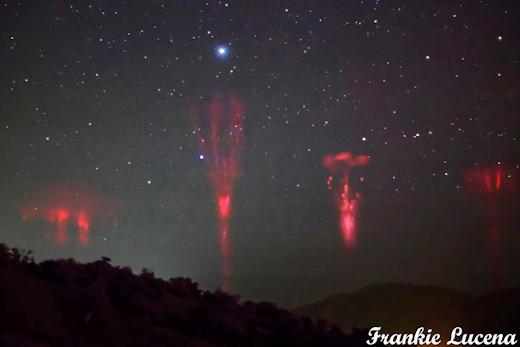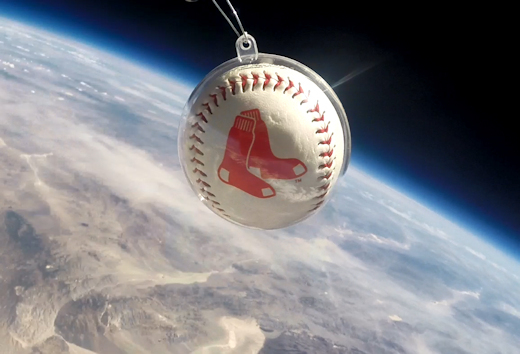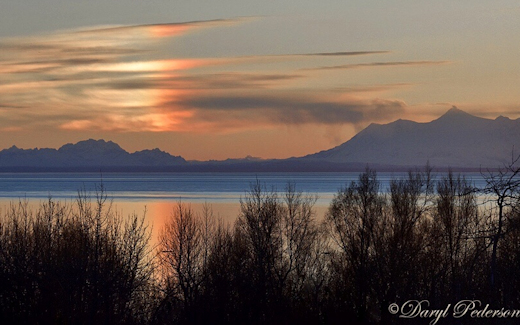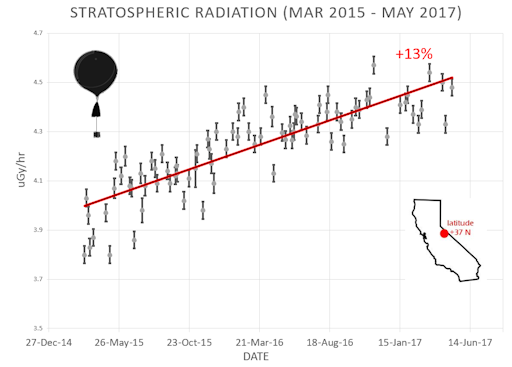 | | | Switch to: Europe, USA, New Zealand, Antarctica Credit: NOAA/Ovation  Planetary K-index Planetary K-index
Now: Kp= 2 quiet
24-hr max: Kp= 2 quiet
explanation | more data
Interplanetary Mag. Field
Btotal: 5.3 nT
Bz: -3.6 nT south
more data: ACE, DSCOVR
Updated: Today at 2347 UT  Coronal Holes: 24 Apr 18 Coronal Holes: 24 Apr 18 
Solar wind flowing from this northern coronal hole might graze Earth's magnetic field on April 26th. Credit: SDO/AIA  Noctilucent Clouds Our connection with NASA's AIM spacecraft has been restored! New images from AIM show that the southern season for noctilucent clouds (NLCs) is underway. Come back to this spot every day to see AIM's "daily daisy," which reveals the dance of electric-blue NLCs around the Antarctic Circle.. Switch view: Ross Ice Shelf, Antarctic Peninsula, East Antarctica, Polar Updated at: 02-07-2018 17:55:05 Noctilucent Clouds Our connection with NASA's AIM spacecraft has been restored! New images from AIM show that the southern season for noctilucent clouds (NLCs) is underway. Come back to this spot every day to see AIM's "daily daisy," which reveals the dance of electric-blue NLCs around the Antarctic Circle.. Switch view: Ross Ice Shelf, Antarctic Peninsula, East Antarctica, Polar Updated at: 02-07-2018 17:55:05  SPACE WEATHER
NOAA Forecasts | | Updated at: 2018 Apr 24 2200 UTC FLARE | 0-24 hr | 24-48 hr | CLASS M | 01 % | 01 % | CLASS X | 01 % | 01 % |  Geomagnetic Storms: Geomagnetic Storms:
Probabilities for significant disturbances in Earth's magnetic field are given for three activity levels: active, minor storm, severe storm Updated at: 2018 Apr 24 2200 UTC Mid-latitudes | 0-24 hr | 24-48 hr | ACTIVE | 10 % | 20 % | MINOR | 01 % | 05 % | SEVERE | 01 % | 01 % | High latitudes | 0-24 hr | 24-48 hr | ACTIVE | 15 % | 20 % | MINOR | 15 % | 25 % | SEVERE | 10 % | 20 % | | | |  | | | | | | | | | | | Lights Over Lapland is excited to announce that our aurora webcam will be up and running 365 days per year! You can now enjoy watching the Midnight Sun and all of the other drama in the sky above Abisko National Park, Sweden here. | | | INCOMING SOLAR WIND STREAM: A stream of solar wind is approaching Earth and it could graze our planet's magnetic field on April 26th. The gaseous material is flowing from a northern hole in the sun's atmosphere. The stream won't hit our planet head on, but sometimes grazing impacts produce interesting effects--for instance, making Earth's magnetosphere ring like a bell. Free: Aurora Alerts HURRICANE SPRITES: Atlantic hurricane season is little more than 1 month away. On the island of Puerto Rico, Frankie Lucena is looking forward to the coming storms with a mixture of excitement and dread. He's still struggling to keep regular power supplied to his private observatory 7 months after Hurricane Maria devastated the island last season. At the same time he knows that passing storms produce something he loves to observe: sprites and gigantic jets. "Tropical storm (later hurricane) Harvey was by far the most prolific," he recalls. Here are four of the upward-lancing forms he photographed when the storm swirled south of Puerto Rico on Aug. 19, 2017: 
"Harvey was a 'TLE Paradise' that night, playing host to wide variety of Transient Luminous Events," says Lucena. "The four events pictured above occurred within a 1 hour period and they were conveniently placed, so I decided to stack them. The one at the extreme left is a sprite, and the rest are Gigantic Jet lightning events."
Lucena's photos of "hurricane sprites" are a testament to his dedication and resourcefulness. After Hurricane Maria knocked out power to Puerto Rico last year, he continued taking pictures, powering his cameras using a gasoline generator and a backup battery. "I wish I had solar power at my house because the lines for gasoline were very long and money spent on it really hurt the pocket. We went 82 days without power," he adds.
How severe storms produce sprites and jets is an area of cutting edge research--and the data are not easy to obtain. The 2018 hurricane season is expected to bring another battery of storms. Lucena would like to avoid another direct hit but, he says, "bring on the sprites." Realtime Aurora Photo Gallery NOW THAT'S A HOMER: No one has ever hit a Red Sox baseball this far before. On Apr. 22, 2018, the students of Earth to Sky Calculus launched one to the edge of space on board a cosmic ray balloon. Riding alongside an array of radiation sensors, the commemorative baseball sailed 33.4 km (109,580 feet) above Earth's surface: 
You can have it for $139.95. The students are selling space baseballs as a fund-raiser for their cosmic ray monitoring program. All proceeds support atmospheric radiation measurements and hands-on STEM education. Are you a fan of a different team? The payload also carried commemorative baseballs for the Royals, Dodgers, Cubs, Yankees, Padres, and Giants. During checkout, enter your preferred team in the COMMENTS section. We will send you the corresponding baseball. If your home team is not on the list, let us know and we will fly it for you on an upcoming flight. Far Out Gifts: Earth to Sky Store
All proceeds support hands-on STEM education VOLCANIC SUNDOGS: Sundogs are common. The rainbow-colored splashes of light frequently appear on either side of the sun when sunbeams lance through icy cirrus clouds. On April 20th, Daryl Peterson of Anchorage, Alaska, witnessed an uncommon type of sundog. "They were volcanic," he says. Take a look at his photo, then scroll down for an explanation: 
"From my location in Anchorage, I can easily see three active volcanoes in the ring of fire group that begins just 90 miles from here, across the Cook Inlet," says Pederson. "On April 20th I was scouting locations that would make great foregrounds for Northern Lights photography. For the first time in a long time I could see activity from all three volcanoes. Just before sunset an intense sundog formed from the steam that had been pumping out of the Mount Spurr stratovolcano."
The steamy exhaust was freezing in the cold Alaska air, forming the ice crystals required for sundog formation. "These rare sundogs were made even more impressive by their reflection on the water," says Pederson. Realtime Space Weather Photo Gallery Every night, a network of NASA all-sky cameras scans the skies above the United States for meteoritic fireballs. Automated software maintained by NASA's Meteoroid Environment Office calculates their orbits, velocity, penetration depth in Earth's atmosphere and many other characteristics. Daily results are presented here on Spaceweather.com. On Apr. 24, 2018, the network reported 26 fireballs.
(18 sporadics, 8 April Lyrids)  In this diagram of the inner solar system, all of the fireball orbits intersect at a single point--Earth. The orbits are color-coded by velocity, from slow (red) to fast (blue). [Larger image] [movies] Potentially Hazardous Asteroids ( PHAs) are space rocks larger than approximately 100m that can come closer to Earth than 0.05 AU. None of the known PHAs is on a collision course with our planet, although astronomers are finding new ones all the time. On April 24, 2018 there were 1907 potentially hazardous asteroids.
 | Recent & Upcoming Earth-asteroid encounters: | Asteroid | Date(UT) | Miss Distance | Velocity (km/s) | Diameter (m) | | 2018 HO1 | 2018-Apr-19 | 11.2 LD | 7.3 | 30 | | 2018 HC1 | 2018-Apr-19 | 1.2 LD | 15.5 | 16 | | 2018 HS | 2018-Apr-20 | 5.1 LD | 18.9 | 35 | | 2018 GS3 | 2018-Apr-20 | 8.5 LD | 19.8 | 24 | | 2016 JP | 2018-Apr-20 | 12 LD | 12.7 | 214 | | 2018 HT | 2018-Apr-21 | 7.1 LD | 7.6 | 15 | | 2018 HL1 | 2018-Apr-21 | 4.7 LD | 14.4 | 53 | | 2018 GR1 | 2018-Apr-21 | 18.3 LD | 16.4 | 52 | | 2018 HN | 2018-Apr-21 | 8 LD | 9.8 | 37 | | 2018 HW1 | 2018-Apr-21 | 0.9 LD | 5 | 21 | | 2018 HX1 | 2018-Apr-22 | 2.7 LD | 25 | 44 | | 2018 HV | 2018-Apr-22 | 0.4 LD | 16 | 6 | | 2018 GG4 | 2018-Apr-23 | 9.8 LD | 14.9 | 20 | | 2018 HY1 | 2018-Apr-23 | 9.5 LD | 7.6 | 31 | | 2012 XL16 | 2018-Apr-23 | 15.8 LD | 6.1 | 28 | | 2018 GH | 2018-Apr-25 | 14.6 LD | 10.7 | 89 | | 2018 HP | 2018-Apr-26 | 11.6 LD | 10.3 | 20 | | 2018 GH5 | 2018-Apr-27 | 12.2 LD | 12.7 | 32 | | 2018 GB2 | 2018-Apr-27 | 17.1 LD | 14.6 | 92 | | 2013 US3 | 2018-Apr-29 | 10.1 LD | 7.7 | 214 | | 2018 GO4 | 2018-Apr-29 | 11.8 LD | 8.6 | 43 | | 2018 GY1 | 2018-Apr-29 | 13.2 LD | 16.7 | 139 | | 2018 FV4 | 2018-Apr-29 | 17.7 LD | 6.5 | 59 | | 2002 JR100 | 2018-Apr-29 | 10.8 LD | 7.7 | 49 | | 2018 HB1 | 2018-May-02 | 10.1 LD | 9.2 | 40 | | 2018 HR1 | 2018-May-04 | 17.2 LD | 16.3 | 48 | | 1999 FN19 | 2018-May-07 | 9.7 LD | 5.7 | 118 | | 2016 JQ5 | 2018-May-08 | 6.3 LD | 10.4 | 9 | | 388945 | 2018-May-09 | 6.5 LD | 9 | 295 | | 2018 GR2 | 2018-May-11 | 13.4 LD | 9.8 | 109 | | 1999 LK1 | 2018-May-15 | 13.3 LD | 10 | 141 | | 2018 GL1 | 2018-May-18 | 14.3 LD | 5.2 | 67 | | 68347 | 2018-May-29 | 9.5 LD | 13.3 | 389 | | 2013 LE7 | 2018-May-31 | 17.8 LD | 1.7 | 12 | | 2018 EJ4 | 2018-Jun-10 | 5.6 LD | 6.2 | 195 | | 2015 DP155 | 2018-Jun-11 | 9 LD | 4.4 | 170 | | 2017 YE5 | 2018-Jun-21 | 15.6 LD | 15.5 | 513 | Notes: LD means "Lunar Distance." 1 LD = 384,401 km, the distance between Earth and the Moon. 1 LD also equals 0.00256 AU. MAG is the visual magnitude of the asteroid on the date of closest approach. | | Cosmic Rays in the Atmosphere |
Readers, thank you for your patience while we continue to develop this new section of Spaceweather.com. We've been working to streamline our data reduction, allowing us to post results from balloon flights much more rapidly, and we have developed a new data product, shown here: 
This plot displays radiation measurements not only in the stratosphere, but also at aviation altitudes. Dose rates are expessed as multiples of sea level. For instance, we see that boarding a plane that flies at 25,000 feet exposes passengers to dose rates ~10x higher than sea level. At 40,000 feet, the multiplier is closer to 50x. These measurements are made by our usual cosmic ray payload as it passes through aviation altitudes en route to the stratosphere over California. What is this all about? Approximately once a week, Spaceweather.com and the students of Earth to Sky Calculus fly space weather balloons to the stratosphere over California. These balloons are equipped with radiation sensors that detect cosmic rays, a surprisingly "down to Earth" form of space weather. Cosmic rays can seed clouds, trigger lightning, and penetrate commercial airplanes. Furthermore, there are studies ( #1, #2, #3, #4) linking cosmic rays with cardiac arrhythmias and sudden cardiac death in the general population. Our latest measurements show that cosmic rays are intensifying, with an increase of more than 13% since 2015: 
Why are cosmic rays intensifying? The main reason is the sun. Solar storm clouds such as coronal mass ejections (CMEs) sweep aside cosmic rays when they pass by Earth. During Solar Maximum, CMEs are abundant and cosmic rays are held at bay. Now, however, the solar cycle is swinging toward Solar Minimum, allowing cosmic rays to return. Another reason could be the weakening of Earth's magnetic field, which helps protect us from deep-space radiation. The radiation sensors onboard our helium balloons detect X-rays and gamma-rays in the energy range 10 keV to 20 MeV. These energies span the range of medical X-ray machines and airport security scanners. The data points in the graph above correspond to the peak of the Reneger-Pfotzer maximum, which lies about 67,000 feet above central California. When cosmic rays crash into Earth's atmosphere, they produce a spray of secondary particles that is most intense at the entrance to the stratosphere. Physicists Eric Reneger and Georg Pfotzer discovered the maximum using balloons in the 1930s and it is what we are measuring today. | | The official U.S. government space weather bureau | | | The first place to look for information about sundogs, pillars, rainbows and related phenomena. | | | Researchers call it a "Hubble for the sun." SDO is the most advanced solar observatory ever. | | | 3D views of the sun from NASA's Solar and Terrestrial Relations Observatory | | | Realtime and archival images of the Sun from SOHO. | | | from the NOAA Space Environment Center | | | fun to read, but should be taken with a grain of salt! Forecasts looking ahead more than a few days are often wrong. | | | from the NOAA Space Environment Center | | | the underlying science of space weather |  | Reviews here can help you to pick up best memory foam mattresses. | | | These links help Spaceweather.com stay online. Thank you to our supporters! | | | | | | | | |  | |  |   | ©2017 Spaceweather.com. All rights reserved. This site is penned daily by Dr. Tony Phillips. | |

